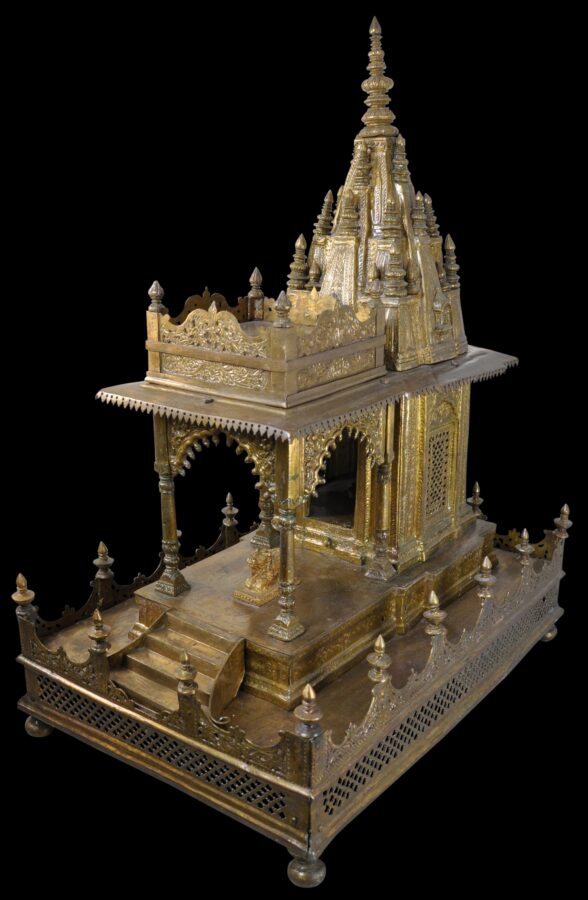Enquiry about object: 9993
Indian Large, Gilded Brass Model of a Shaivite Shrine
probably Maharashtra, India late 19th century-early 20th century
height: approximately 52cm, length: 38.9cm, width: 26cm
Provenance
UK art market
This elaborate gilded brass model of a Shaivite shrine or temple holds a shivalingam (the phallic representation of the god Shiva) in its interior and a model of Nandi (Shiva’s vahana or celestial vehicle) in the exterior vestibule or porch (mandapa) which sits, crouched in obeisance, facing the shivalingam.
The shrine is in an enclosure surrounded by an elaborate fence with pointy finials and pierced skirting. Steps lead to the mandapa. The figure of Nandi sits before doors that open to reveal the inner shrine with the shivalingam, A tiered shikara rises over the structure that houses the shivalingam.
The shrine ensemble stands on four spherical feet. Pierced skirting runs around the base of the model.
The shrine would have been placed so that its inner sanctum would have been at eye level. The section of a shrine that houses the shivalingam was known as the garbagriha, and in an actual shrine or temple, generally this was only accessed by the temple’s priests.
Models of temples or shrines were produced in India for local, religious use – several examples are in the British Museum – and also for export as decorative works of art. One example, attributed to 18th-19th century, is of sandstone, from central India, and for Shaivite worship. It has a shivalingam inside.
Shiva is a deity that delights in outrageous conduct and moral ambivalence, but also one that is prone to unpredictable behaviour. These aspects are humanising and for many, Shiva’s complex character is adored and subject to much devotion. Shiva is also associated with fertility (and hence prosperity) and so a popular deity for the household altar. The fertility aspect is encapsulated by the lingam, which is the most common form in which Shiva is worshipped. The lingam form though is not seen as sexualised but rather is a symbol of energy and the potentiality of the god (Blurton, 1992, p. 78).
References
Blurton, T.R., Hindu Art, The British Museum Press, 1992.
Bromberg, A., et al., The Arts of India, Southeast Asia, and the Himalayas: At the Dallas Museum of Art, Yale University Press, 2013.
Michell, G., et al, In the Image of Man: The Indian Perception of the Universe through 2000 Years of Painting and Sculpture, Arts Council of Great Britain, 1982.








